Summary
The market experienced a dramatic reversal in October: the Federal Reserve's interest rate cut not only failed to boost the market but instead triggered a massive crash in the cryptocurrency sector, amounting to $400 billion. The core contradiction lies not in macro policies but in a fatal weakness within the market—when the black swan of Trump's tariffs struck, high leverage instantly pierced through thin liquidity. However, the real story lies beneath the rubble: new narratives such as AI + crypto, RWA, and prediction markets have quietly emerged, laying the groundwork for the next bull market. This article will penetrate the fog of price fluctuations to reveal the truth behind this liquidity crisis and future opportunities.
I. The Background of the Federal Reserve's Rate Cut: A Feast of Liquidity and Structural Changes
On October 30, the Federal Reserve implemented its second rate cut of the year, lowering the target range for the federal funds rate to 3.75%-4.00%. This decision stemmed from the unique predicament facing the U.S. economy—dual risks of rising inflation pressures and a slowing job market.
Federal Reserve Chairman Powell admitted, "There is no risk-free path." This predicament has made the Fed's decision-making exceptionally difficult and has introduced uncertainty into subsequent policies.
The market's reaction to the rate cut was unexpected. Rate cuts are supposed to boost risk assets, but the cryptocurrency market saw massive sell-offs in October. This indicates that investors had already priced in the rate cut expectations, and when the actual cut occurred, it triggered profit-taking.
(1) Federal Funds Rate

The Federal Reserve's decision to cut rates by 25 basis points in October was largely in line with market expectations. The key driving factor behind this decision was the noticeable slowdown in the job market. The statement from this meeting removed the phrase "the labor market remains strong" and instead emphasized "job growth has slowed, and the unemployment rate has risen slightly."
(2) Federal Reserve Balance Sheet
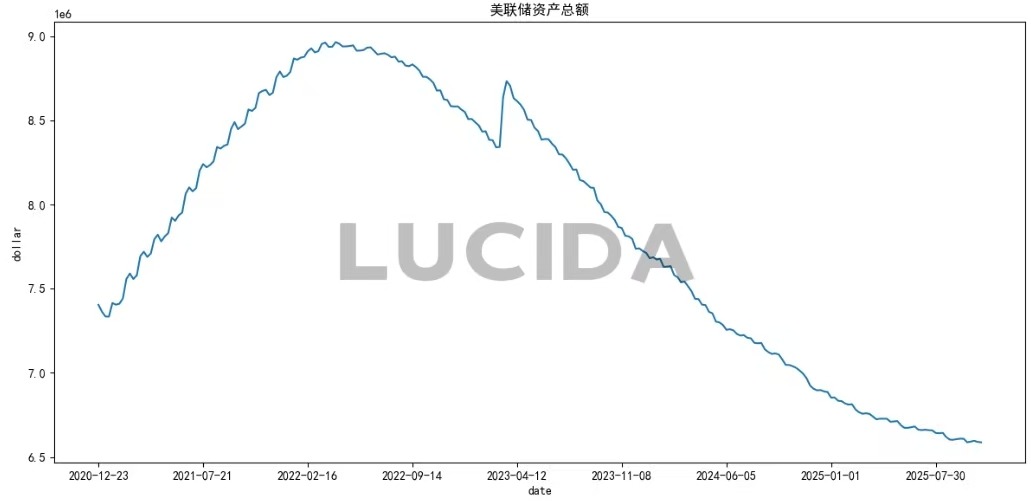
On October 30, after holding the interest rate meeting, the Federal Reserve made two key decisions: first, it announced a 25 basis point rate cut, lowering the target range for the federal funds rate to 3.75%-4.00%; second, it clearly stated that it would stop reducing its balance sheet starting December 1 (i.e., ending quantitative tightening, QT). This means that the current plan to reduce $50 billion in U.S. Treasury securities and $35 billion in mortgage-backed securities (MBS) each month will cease. Chairman Powell pointed out that this decision was made because "pressure in the money market requires immediate adjustments to balance sheet operations," and acknowledged that there are "clear signs" that it is time to stop quantitative tightening.
This policy shift is ostensibly a response to the tightening liquidity pressures in the money market—the scale of overnight reverse repurchase agreements has plummeted from a peak of $460 billion earlier in the year to less than $6 billion, and the bank reserve ratio hovers around the critical level of 12.2%. However, behind this lies the Federal Reserve's monetary policy dilemma under high debt constraints. The total U.S. federal government debt has now surpassed $38 trillion, with net interest payments approaching the scale of defense spending. Continuing to maintain a tight balance sheet policy, while helping to curb inflation, would significantly raise government financing costs and could even trigger debt risks. Therefore, stopping the balance sheet reduction is also the Federal Reserve's attempt to seek a difficult balance between inflation control and debt sustainability.
Looking ahead, the trajectory of the Federal Reserve's balance sheet has begun to reveal a path of "first stopping the reduction, then expanding the balance sheet." Powell has made it clear after the October meeting: "Ultimately, the Federal Reserve will expand its balance sheet again," as the normal functioning of the economy and banking system requires a corresponding increase in reserves. This means that after stopping the balance sheet reduction on December 1 and maintaining stability for a period, the Federal Reserve may restart asset purchases at some point in the future, although the structure of the purchases will focus more on short-term Treasury securities to reduce the overall duration of assets.
This series of changes has profound implications for the market. Stopping the balance sheet reduction itself is seen as a form of "implicit easing," as it no longer withdraws liquidity from the market but instead provides potential fresh water for the financial system. Some analysts believe this move could have a loosening effect equivalent to a 25 basis point rate cut. Historical experience shows that marginal changes in the Federal Reserve's balance sheet significantly impact real yields, dollar flows, and risk appetite. If the liquidity environment improves as a result, cryptocurrencies like Bitcoin, which are highly sensitive to liquidity, may welcome a new round of valuation support.
(3) U.S. Core PCE Price Index for September
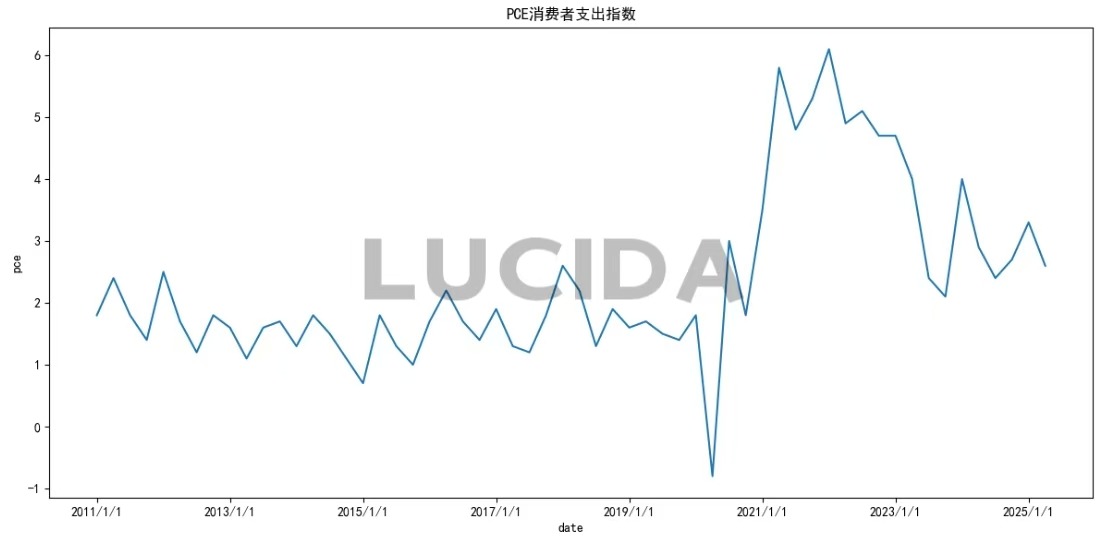
Due to the U.S. government shutdown, the core PCE data for October was not released. However, as the inflation indicator most closely watched by the Federal Reserve, the PCE price index for September rose 2.7% year-on-year, slightly higher than July's 2.6%; it increased 0.3% month-on-month, accelerating by 0.1 percentage points compared to July. The more closely watched core PCE price index (excluding food and energy) rose 0.2% month-on-month and 2.9% year-on-year, unchanged from July. By category, service prices increased by 0.3%, mainly reflecting increases in airfares, hotel accommodations, financial services and insurance, housing, and utilities. Commodity prices rose slightly by 0.1% month-on-month, with a 1.7% decline in the prices of entertainment products and vehicles offset by slight increases in other durable goods and gasoline prices. The Federal Reserve believes that the impact of tariffs on inflation is relatively mild, contributing about 0.3%-0.4% to core PCE, and the transmission speed is slow. Powell stated, "In the short term, the risks to inflation are tilted to the upside, while the risks to employment are tilted to the downside—this is a challenging situation."
(4) U.S. Dollar Index
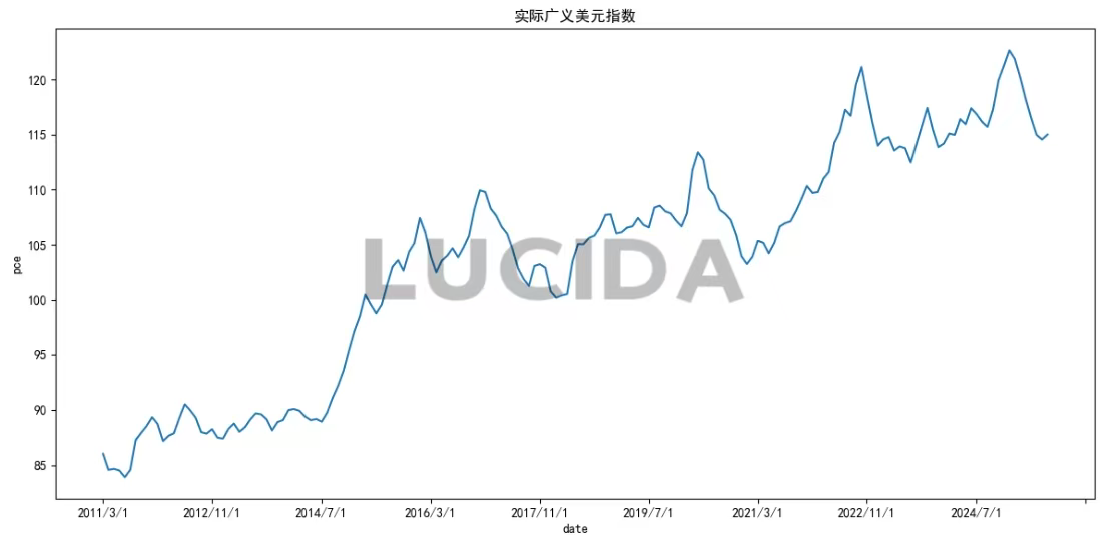
The U.S. dollar index weakened briefly after the Federal Reserve's rate cut, but due to the European Central Bank and the Bank of Japan maintaining loose monetary policies, the dollar did not continue to decline. This trend reflects the policy differences among major central banks. Although the Federal Reserve has begun a rate-cutting cycle, other major central banks have also maintained a loose stance, limiting the scope for significant depreciation of the dollar. Long-term U.S. Treasury yields remain high (with the 10-year yield rising to 4.145%), continuing to attract safe-haven funds back to the U.S., further weakening the impetus for a significant decline in the dollar.
Conclusion
It is evident that the rate cut was a decision made by the Federal Reserve under triple constraints. The weakness in the job market became the key factor triggering the rate cut. The Federal Reserve's decision in October faced rare internal resistance. The policy statement indicated that Kansas City Fed President Jeffrey Schmid opposed the rate cut, advocating for maintaining rates, while Governor Stephen Milan believed the cut was insufficient and called for a one-time reduction of 50 basis points. This divergence highlights the Federal Reserve's dilemma in balancing inflation and growth. Powell described the current economic outlook as "driving in the fog," emphasizing the uncertainty of the policy path. Despite the Federal Reserve continuously signaling easing, the digital currency market reacted tepidly. Bitcoin overall showed a nearly 5% decline in October, breaking a six-year streak of "Uptober" gains. This divergence reveals the market's skepticism towards easing policies—when rate cuts stem from economic concerns rather than healthy growth, risk assets struggle to gain sustained momentum.
II. Observing Cryptocurrency Market Sentiment
(1) Total Market Capitalization
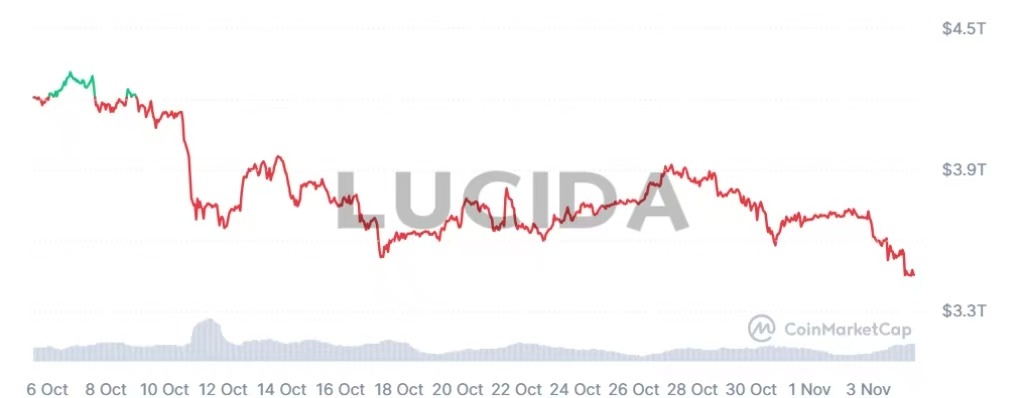
Total market capitalization is the ultimate result and overall reflection of market sentiment. Its fluctuations are a comprehensive product of price changes of all individual tokens, capital inflows and outflows, and market confidence. In October, total market capitalization experienced a roller-coaster journey: on October 5, benefiting from the strong rise of Bitcoin and Ethereum, total market capitalization briefly reached a historic high of $4.35 trillion. However, during the "10·11" crash, it fell by more than 9% in a single day, resulting in a significant evaporation of market value. By the end of October, total market capitalization had retreated to about $3.4 trillion, with this rise and fall profoundly revealing the severe contraction of wealth effects during market panic and deleveraging.
(2) Altcoin Season Index

The core logic of the Altcoin Season Index is to measure how many mainstream altcoins outperform Bitcoin within a specific cycle. When the index falls below 75, especially in the 20-30 range (i.e., "Bitcoin Season"), it indicates that funds are flowing out of high-risk altcoins into the more stable Bitcoin, which is typically characteristic of market risk-averse periods or the early stages of a bull market. This was confirmed at the end of October when the index stood at 32, confirming that the market was in risk-averse mode.
Looking back to early October, the index had once reached 78, clearly indicating "Altcoin Season." This rapid switch from "Altcoin Season" to "Bitcoin Season" clearly reveals the shift in market hotspots. Historically, when the index rebounds strongly from a low level (such as 15 or 17) to above 30 for the first time, it may signal the beginning of capital rotation, making it an early signal worth closely monitoring and gradually positioning in altcoins. However, investors should also be cautious, as altcoin cycles are usually shorter and more volatile than Bitcoin cycles.
(3) Fear and Greed Index
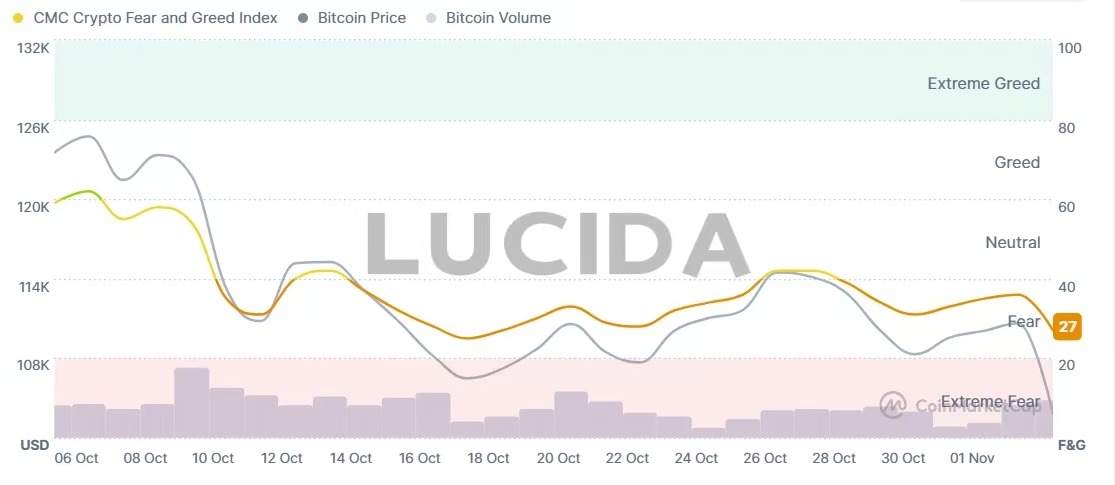
The Crypto Fear and Greed Index experienced a dramatic swing from "Greed" to "Extreme Fear" from October to early November. The index reached a "Greed" high of 74 on October 5, when Bitcoin's price was also nearing its historical peak. However, as the market plummeted due to macro concerns (such as Trump's tariff threats) and internal structural risks (such as high leverage liquidations), the index sharply dropped to 21 on November 4, entering the "Extreme Fear" zone. This extreme reversal in sentiment not only reflects the fragility of investor confidence but also often serves as a contrarian indicator for assessing short-term market overselling or potential rebound timing—some analysts believe that this extreme market anxiety may signal that a phase bottom is forming. Additionally, during the October crash, Bitcoin's dominance increased while market trading volume and social sentiment declined across the board, collectively pushing sentiment towards the "Fear" end.
III. Tracking Hot Sectors and Core Narratives
Despite the overall lackluster performance of the market, funds and enthusiasm have not exited but have instead regrouped in key tracks, showcasing significant structural differentiation. The flow of institutional funds contrasts sharply with community-driven trends, outlining a diverse picture of the current market.
(1) Institutional Layout: Stable Funds Anchoring Core Tracks
In the midst of volatility, institutional funds have shown clear preferences. Bitcoin and Ethereum spot ETFs recorded net inflows of $5.55 billion and $1.01 billion, respectively, indicating that long-term confidence remains unchanged. More importantly, the total circulation of stablecoins increased by $9.38 billion, suggesting that a significant amount of off-market funds is waiting for the right entry opportunity. These robust funds are primarily flowing into several core narrative tracks:
The integration of AI and crypto is advancing deeply, centered around the competition for "computing power, data, and ownership of intelligent agents." The ERC-8004 standard has achieved the tokenization of AI agents, while Coinbase's x402 protocol has built an open channel for payments between agents.
RWA (Real World Assets) is experiencing explosive growth, with the tokenization of U.S. Treasury bonds skyrocketing from $800 million to over $7.3 billion, led by traditional financial giants like BlackRock's BUIDL and Franklin Templeton.
The popularity of prediction markets continues, with Polymarket and Kalshi's trading volume increasing nearly fivefold, and the parent company of the New York Stock Exchange planning an investment of up to $2 billion to further mainstream this track.
(2) Technological Evolution and Regulatory Dividends Progressing Together
While institutional funds are laying out in mainstream tracks, technological evolution and regulatory changes are also creating new opportunities:
Competition in the privacy technology sector is heating up, with three major paths—trusted execution environments, zero-knowledge proofs, and fully homomorphic encryption—competing for future standard dominance.
Yield-generating protocols have become the new favorites, with DeFi protocols generating approximately $600 million in fees in September, and Hyperliquid allocating 95% of its revenue over the past 30 days for token buybacks and rewards for holders.
New crypto banks and stablecoins are seeing a turnaround following the passage of the GENIUS Act, with stablecoin payment volumes increasing by about 70%, demonstrating the direct impact of clearer regulations on applications.
(3) Community Enthusiasm: The Contrarian Frenzy of Meme Coins
In stark contrast to the rational layout of institutions is the frenzy in the meme coin market. Projects like BALZ have rapidly emerged on the BNB chain, raising over $2 million in just a few days and attracting more than 40,000 community members. Chinese meme coins have quickly gained popularity in the Binance, Solana, and Base ecosystems, with phenomenon projects like "Binance Life" experiencing a short-term surge in market value, attracting a large number of new traders, yet also highlighting their sustainability limitations.
This differentiated pattern clearly depicts the complexity of the current market: institutional funds are steadily laying out in core tracks with long-term value, while community enthusiasm seeks short-term explosive opportunities in the meme coin sector. These two main lines run parallel, together forming a complete picture of the October market.
IV. Regulatory Landscape: East-West Divergence
At the forefront of global regulation, there is a clear divergence in policy orientation between the East and West.
The UK has adopted a more lenient stance towards cryptocurrencies, opening the London Stock Exchange to digital assets and lifting a four-year ban on trading notes on cryptocurrency exchanges. Analysts predict that this move could lead to a 20% growth in the UK cryptocurrency market.
In contrast, Pan Gongsheng, Governor of the People's Bank of China, stated at the 2025 Financial Street Forum Annual Meeting that "the People's Bank will continue to crack down on speculation in digital currencies to maintain financial order while dynamically tracking the development of overseas stablecoins."
U.S. regulation has also seen significant breakthroughs. The SEC has approved the Hashdex Nasdaq Crypto Index US ETF to operate under the new general listing standards, allowing it to hold XRP, SOL, and XLM in addition to BTC and ETH. This decision paves the way for more diversified crypto ETF products and could significantly alter the allocation pattern of institutional funds.
V. Investment Advice: Seeking Certainty Amid Uncertainty
Looking ahead, the cryptocurrency market is at a critical juncture of narrative transition.
The future policy path of the Federal Reserve will primarily depend on balancing two aspects: the degree of slowdown in the job market and the sustainability of inflation decline. Standard Chartered Bank predicts that the dollar will slightly rebound to 100 in the next 1-3 months.
From a market structure perspective, although the flash crash in October was painful, it was also a necessary deleveraging process. Data shows that after the event, open interest decreased from $4.87 billion to $4.51 billion, and funding rates fell by 51%. A market driven by belief, where institutional capital seeks new allocation opportunities, is forming. Technological innovation will continue to drive market development. Narratives such as AI agents, prediction markets, and RWA not only represent the technological frontier but also serve as the steering wheel for capital flows. Against the backdrop of sluggish traditional economic growth, these tracks may become the forerunners of market recovery in the next six months.
免责声明:本文章仅代表作者个人观点,不代表本平台的立场和观点。本文章仅供信息分享,不构成对任何人的任何投资建议。用户与作者之间的任何争议,与本平台无关。如网页中刊载的文章或图片涉及侵权,请提供相关的权利证明和身份证明发送邮件到support@aicoin.com,本平台相关工作人员将会进行核查。




